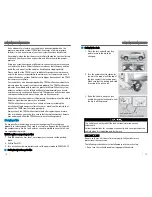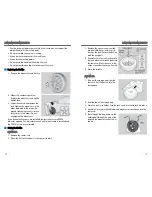
5. While pushing the key down, press the shift lever release button and place
the shift lever into Neutral (N). The lock is now released. Have the shift lever
checked by a dealer as soon as possible.
Jump Starting
Turn off the power to electric devices, such as audio and lights. Turn off the
engine, then open the hood.
1. Connect the first jumper cable to your
vehicle's battery (+) terminal.
Remove the cover from the under-hood
fuse box. See (Engine Compartment
Fuse Boxes)
2. Connect the other end of the first
jumper cable to the booster battery (+)
terminal. Use a 12-volt booster battery
only.
When using an automotive battery charger, select a charging voltage lower
than 15 volts. Check the charger manual for the proper setting.
3. Connect the second jumper cable to the booster battery (-) terminal.
4. Connect the other end of the second
jumper cable to the engine hanger as
shown. Do not connect this jumper
cable to any other part.
5. If your vehicle is connected to another
vehicle, start the assisting vehicle's
engine and increase its rpm slightly.
6. Attempt to start your vehicle's engine. If
it turns over slowly, make sure that the
jumper cables have good metal-to-metal contact.
A battery can explode if you do not follow the correct procedure, seriously
injuring anyone nearby.
Keep all sparks, open flames, and smoking materials away from the battery.
Battery posts, terminals, and related accessories contain lead and lead
compounds. Wash your hands after handling.
HANDLING THE UNEXPECTED
106 |
Overheating
Signs your engine is overheating:
• The temperature gauge needle is at the H mark
• The engine suddenly loses power
• Steam or spray comes out from under the hood
First thing to do:
1. Immediately park the vehicle in a safe
place. Turn off all accessories and turn
on the hazard warning lights.
2. If no steam or spray is present: Keep
the vehicle running and open the hood
(See Under the Hood).
If steam or spray is present: Turn off the
engine and wait until it subsides. Then,
open the hood (See Under the Hood).
3. Check that the cooling fan is operating and stop the engine once the
temperature gauge needle goes down. If the cooling fan is not operating,
immediately stop the engine.
4. Once the engine has cooled down, inspect the coolant level and check the
cooling system components for leaks. If the coolant level in the reserve tank
is low, add coolant until it reaches the MAX mark. If there is no coolant in
the reserve tank, make sure the radiator is cool, then cover the radiator cap
with a heavy cloth and open the cap. If necessary, add coolant up to the
base of the filler neck, and put the cap back on.
Once the engine has cooled sufficiently, restart it and check the temperature
gauge. If the temperature needle has gone down, resume driving. If it has not
gone down, contact a dealer for repairs.
Steam and spray from an overheated engine can seriously scald you.
Do not open the hoodif steam is coming out.
Removing the radiator cap while the engine is hot can cause the coolant to
spray out, seriously scalding you.
Always let the engine and radiator cool down before removing the radiator
cap.
HANDLING THE UNEXPECTED
| 107















































